Generating Framing in Home Designer Pro
The information in this article applies to:

QUESTION
What is the best way to approach framing in Home Designer Pro?
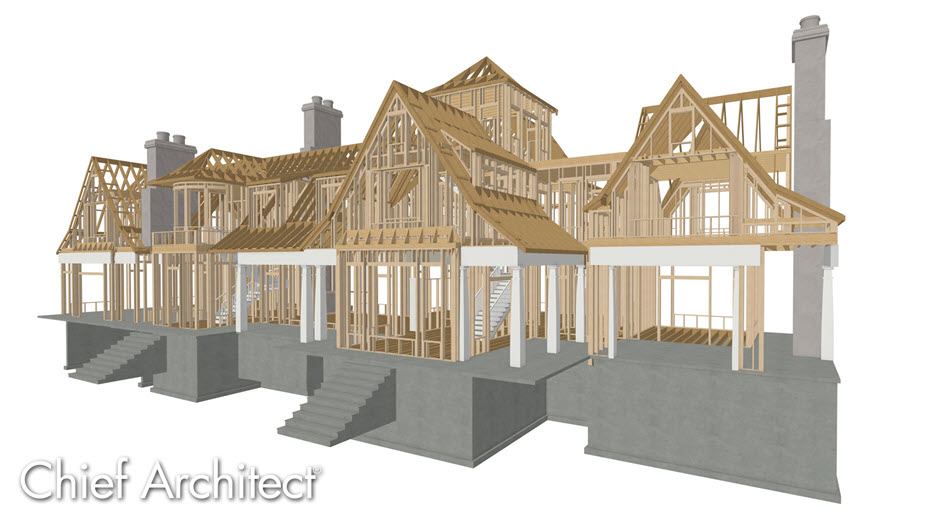
ANSWER
There are some common practices that can be employed when building framing in Home Designer Pro, specifically:
- Setting framing defaults
- Generating automatic framing
- Manually building and editing framing
-
Preparing an existing plan for new framing
Before you begin drawing your plan or generating framing, it is recommended you set up your framing defaults to reflect the way you want the structure to be built. Changing these values after the structure is complete may require you to re-do work and lower your productivity
To set framing defaults
- Select Edit> Default Settings
 from the menu, select the Framing category, then click Edit.
from the menu, select the Framing category, then click Edit.
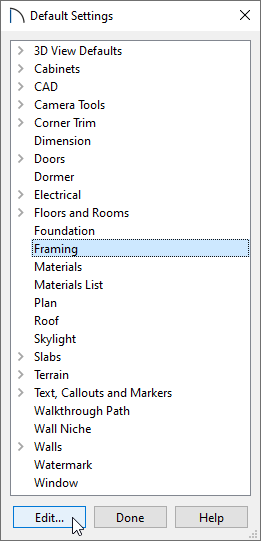
- In the Framing Defaults dialog, visit each panel and specify the spacing, framing member size, framing member type, and other information to your liking, then click OK.
Note: While all framing default settings are important to your structure, the floor framing will be the most time consuming to change after your plan is complete.
- Remaining in the Default Settings, expand the Floors and Rooms category, select the Floor/Ceiling Platform option, then click Edit. In the Floor/Ceiling Platform Defaults dialog, make any desired changes to the Floor/Ceiling Structure, as necessary, then click OK.
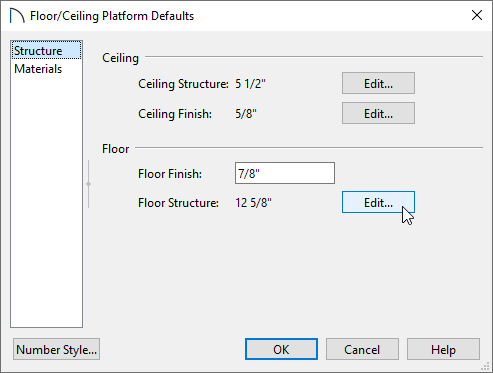
-
Edit the Roof defaults to your liking, particularly the options located on the Structure panel, then click OK.
- If you need to adjust the framing wall layers located within your Wall Types, expand the Walls category, select a Wall tool, click Edit, then select the Define button located on the Wall Types panel. This will open the Wall Type Definitions dialog. After making any desired changes, click OK.
For more information on modifying wall types, please see the appropriate resource located in the Related Articles section below.
- Expand the Doors default category, Edit each of the Door tools, and access the Framing and Rough Opening panels to modify the associated properties. Perform the same procedure for the Window defaults.
- Once all desired changes have been made to the defaults, click Done.
You can build framing at any time, however, any structural changes made will not update the framing unless automatic framing is enabled or the framing is rebuilt. Additionally, any customized framing will need to be re-drawn each time the framing is rebuilt. As such, it may be best to wait until you are confident that your plan is in its final state before framing is generated.
To generate automatic framing
- Select Build> Framing> Build Framing
 from the menu.
from the menu.
Note: A Build All Framing tool is also available, allowing you to quickly build, or rebuild, all floor, ceiling, wall, and roof framing throughout the current plan with a single click. This is only recommended after you have set all of your framing properties to your liking.
- In the Build Framing dialog, check the appropriate boxes under either the Automatically Rebuild Framing or Build Framing Once section.
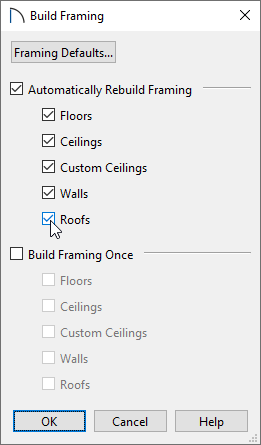
In Home Designer Pro 2024 and prior, visit each panel and check the appropriate Build or Automatically Build Framing box.
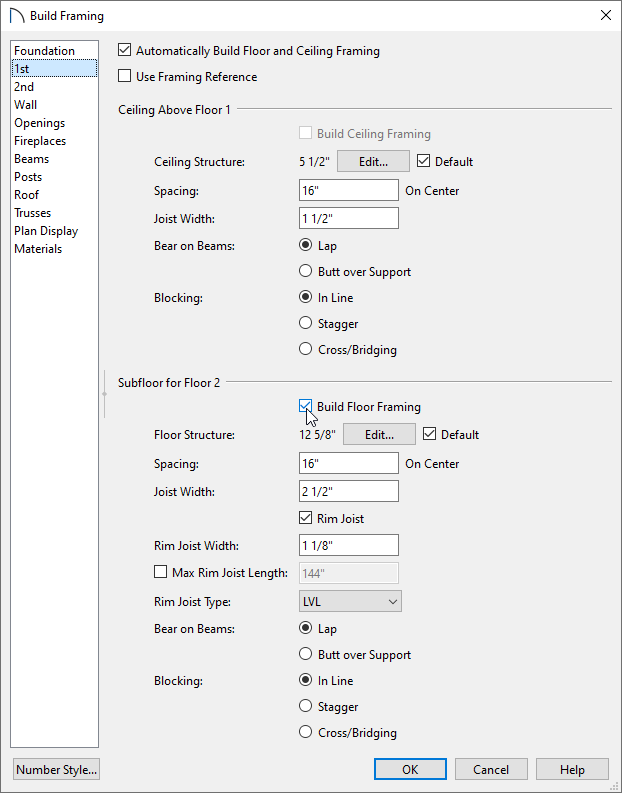
- Click OK to generate framing throughout your plan.
It is common to use a combination of both automatic and manual framing in a single Home Designer Pro plan.
To manually build or edit framing
- Floor, ceiling and roof framing members can be selected and edited in a floor plan view.
If you don't see particular framing members in the view, the layer(s) the framing is on may be turned off. Navigate to Tools> Display Options and toggle on the display of any framing layers you would like to see.
- Rafters, trusses, joists, and wall framing can be created using the various Framing tools, accessible by navigating to Build> Framing
 .
.
For more information on manually drawing framing members, please see the Related Articles section below.
Sometimes, it is necessary to make structural changes to a plan that has already been drawn. All framing members can be deleted before new framing defaults are set and new framing members are generated.
To prepare an existing plan for new framing
- Before making changes that will affect floor, ceiling and/or roof plane heights, it is recommended that you first delete your framing, including wall framing.
- Select Edit> Delete Objects
 .
.
- Click the radio button beside All Floors.
- Check the boxes beside Floor Framing, Ceiling Framing, Roof Framing, Roof Trusses and Wall Framing.
You may receive a message stating: "Cannot delete framing while Automatic Framing is on. Do you wish to turn automatic framing off and delete all framing?". Click Yes to proceed.
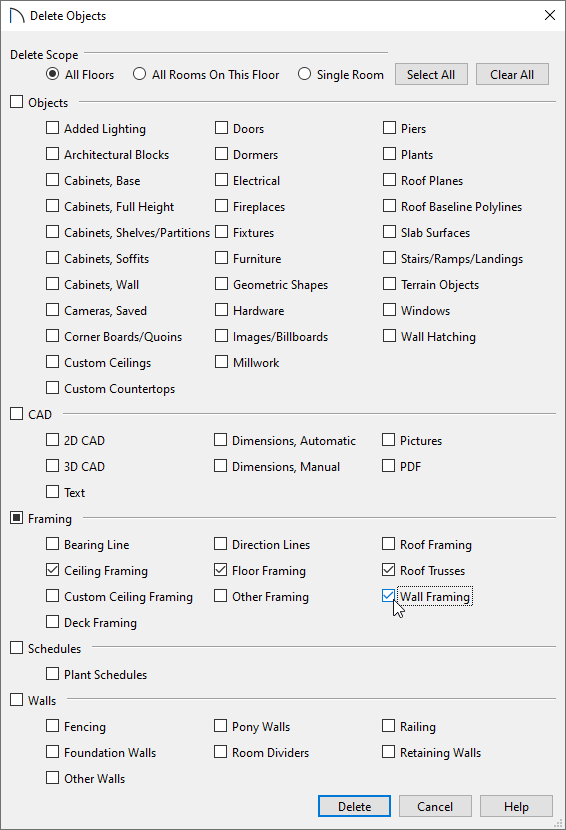
- Click Delete to delete the specified framing objects in your plan.
- Select Edit> Delete Objects
- It may also be necessary to either raise or delete the existing roof planes.
-
To raise the roof planes enough to accommodate changes, hold Shift and click on each roof plane that needs to be modified, then click the Transform/Replicate Object
 edit button.
edit button.
- In the Transform/Replicate Object dialog, check the box beside Move and specify the desired distance to raise or lower the roof planes along the Z Delta.
- If you would rather delete the roof completely to start over, select Build> Roof> Delete Roof Planes
 from the menu.
from the menu.
-
To raise the roof planes enough to accommodate changes, hold Shift and click on each roof plane that needs to be modified, then click the Transform/Replicate Object
- It may be beneficial to reset your floor and ceiling heights back to their default values.
- Select Edit> Reset to Defaults.
- Click the radio button beside All Floors.
- Check Floor Heights and Ceiling Heights, then click OK to reset the floor and ceiling heights for the rooms on all of your floors back to their floor's default values.
- Select Edit> Reset to Defaults.
- Make the needed changes to your plan's structure.
- Begin on the lowest floor and work upwards towards the attic.
- Remember that changes made to the Framing and Floor Defaults will not affect any rooms that are not using the default values.
For example, rooms with sunken floors should be examined individually and their heights adjusted as needed.
- Begin on the lowest floor and work upwards towards the attic.
- When your structural changes are complete, you can now rebuild your framing and, if necessary, your roof.